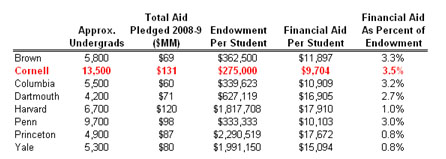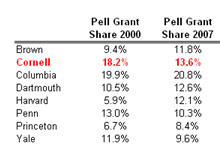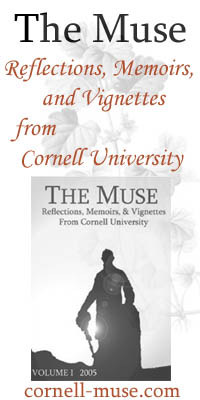Amidst the recent flurry of announcements regarding financial aid policies, it may be hard to see the forest through the trees, especially if one solely relies on the gushing press releases published by each school's own public relations machine. But a careful analysis of the recent financial aid announcements - considered within the context of each school's respective financial well-being - indicates that Cornell is the Ivy most generous with its money. For the time being, I've limited this analysis to schools within the Ivy League. Although Cornell definitely overlaps with a lot more schools than just the Ivy schools for a variety of reasons, the figures for these schools tend to be a lot more readily accessible than for other schools. Moreover, there has been a lot of interest recently in how financial aid packages will impact the competitive parity of the Ancient Eight. The first table lists each school's estimated financial aid payout in 2008-9 after all of the recent policy changes are adopted. (Sources found after the jump.) It compares the average financial aid package per undergraduate and total undergraduate financial aid relative to the institution's endowment. While a comparison to a school's endowment isn't ideal for a bunch of reasons, its the best quick and easy measure of a school's financial resources available. What becomes pretty clear is that in 2008-9 Cornell will be outspending every Ivy on financial aid -- both in absolute terms and relative to its endowment. But it also lags the League in terms of aid spent per student, meaning Cornell's average financial aid package is not as attractive as its peers on the playing field.

In this light, Cornell's policy is unequivocally the most generous in the League -- Day Hall is dedicating the highest amount of resources to ensure that students can afford a world-class education.
It's pretty evident that there are three tiers in the League. Harvard, Yale, and Princeton -- the Big Three -- offer the most aid per student, but also pledge the least amount of resources relative to their endowment. Meanwhile, Brown, Cornell, Columbia, and Penn generally offer the least amount of aid per student, with packages that generally can't compete with the Big Three, but need to dedicate three times as much of their financial resources to do so. Dartmouth is squeezed in the middle; spending just as much per student as the Big Three, but having to dedicate almost three times as much of its resources to do so.
The one thing missing in this analysis is the financial well-being of the student body. The more socio-economically diverse the student body is, the more the University's resources will be stretched to provide aid.
Cornell has always prided itself in educating a socio-economically diverse student body. Just look at the share of students on federal Pell grants. This diversity is part of the institution's founding principles, and it's fair to say that, more so than any of its Ivy brethren, Cornell has served as an engine of American meritocracy -- just look at the Washington Monthly's annual ranking of colleges.

But this fact has strapped Cornell's resources even more. And it has now become clear that amidst the recent financial aid arms race, Cornell has found itself becoming less socioeconomically diverse. It's still the second-most diverse school in the League, and I suspect Columbia's numbers may be skewed by its General Studies school.
The Daily Sun ran an article on this very point on Friday. But its analysis was a bit misleading and unbalanced, focusing on the absolute number of Pell grants awarded, and not the share of students receiving these grants. We're still educating more students on Pell grants than Harvard, Yale, and Princeton combined, and have a higher share of recipients.
Still, the numbers are sobering, and indicate that competitive pressures are changing the face and spirit of Cornell. Ezra's university may have gone "no-loan" but it still hasn't gone "tuition free". And the perverse economics of higher education -- with competing interests for top facilities, top faculty, top students, and top sports teams -- suggests that this trend isn't going away anytime soon. If we want Cornell to be competitive for the best and brightest students going forward, either us alumni or the State of New York are going to have to start paying up. Day Hall is already stretched too thin.


